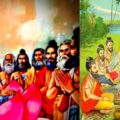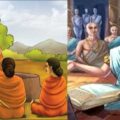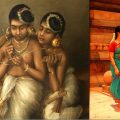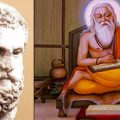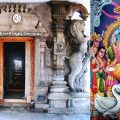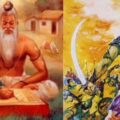Saptarshis: Lineages of Angirasa gotra from 14050 BCE
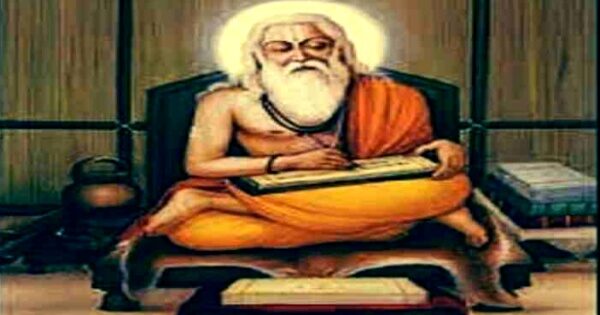
Aṅgiras was the Mānasaputra of Brahma I and the contemporary of Svāyambhuva Manu. Brihaspati I of Āṅgirasa gotra lived around 14000 BCE. Purāṇas give the detailed genealogy of Āṅgirasa family from Atharva Āṅgirasa (14050 BCE).
Brahmānda Purāṇa gives the genealogical account of Rishi Atharva Āṅgirasa. Atharva had three wives: Surūpā (daughter of Rishi Marīchi), Svarāt (daughter of Rishi Kardama) and Pathyā (a descendant of Manu dynasty). Brihaspati I was born to Surupā, and Gautama, Ajasya, Vāmadeva I, Utathya and Uśija were born to Svarāt. Dhriṣṇi, Samvarta and Mānasa were born to Pathyā.
Dīrghatamas I (13500 BCE) was the son of Utathya and Mamatā. Kitava was the son of Ayāsya I. Brihaduktha was the son of Vāmadeva I. Dhriṣṇi’s son was Sudhanvā. Riṣabha was the son of Sudhanvā. The Ribhus, known as Rathakāras (chariot makers), were the descendants of Sudhanvā. Bhāradwāja I was the son of Brihaspati I. Dīrghatamas I Māmateya was blind by birth. He married Pradveśī. Rishi Gautama was born to them. Dīrghatamas I had a son named Kakśīvant I from a Śūdra woman named Pajra or Auśīnarī. The descendants of Kakśīvant I went to Girivraja and became Brāhmaṇas, known as Pajra Kakśīvant and later as Kuśamanda Gautamas.
Rishi Śardvān I, son of Gautama was the paternal cousin of Dīrghatamas II (11150 CE). Śatānanda was the son of Śardvān I and Ahalyā I, daughter of Vadhyāśva. Vadhyāśva was the son of Brahmiṣṭḥa and Indrasenā, and the grandson of Mudgala. Divodāsa was the son of Vadhyāśva. Mitrayu and Maitreya were the descendants of Divodāsa.
Brihaspati II (11220 BCE), a descendant of Aṅgirasa, was the contemporary of Uśanas or Śukrāchārya. He had a son named Kacha. Ayāsya Āṅgirasa (11250 BCE) was the contemporary of King Hariśchandra (11250 BCE). Ajīgarta, the father of Śunaḥśepa, was also an Āṅgirasa as mentioned in Aitareya Brāhmaṇa.
The Mahābhārata indicates that Uchathya was the contemporary of King Māndhātā, the son of Yuvanāśva (Uchathyo Brahmavittamaḥ… Māndhātre Yauvanāśve… abhyabhāṣata). Dīrghatamas II was the son of Uchatya. He authored many hymns of the first Mandala of Rigveda. He was the first who referred to twelve harmonic divisions of a zodiac of 360 degrees, twelve solar months, 360 days and 720 days and nights. Dīrghatamas II was not blind, which is evident from the content of his hymns. He married Uśijā. Kakśīvant was the son of Dīrghatamas II and Uśijā. There was another Brihaspati, a contemporary of King Māndhātā. He married off his daughter, Romaśā, to King Svanaya Bhāvayavya.
Eventually, the many lineages of Aṅgirasa gotra (Ayāsya, Auchathya, Auśija, Vāmadeva, Bhāradwāja, Sānkrita, Garga, Kaṇvarathītara, Mudgala, Vishnuvriddha, Hārīta, Kapi, Rukśabharadwāja, Ārṣabha and Kitava) evolved. Seemingly, Rishi Kapi of Aṅgirasa gotra was probably the progenitor of Kapis (Vānaras) of Kishkindha of the Rāmāyaṇa era. Later, Kapi became synonymous with Vānara (monkey) in Laukika Sanskrit. Vishnuvriddha and Hārīta lineages evolved from Rajarshi Māndhātā and absorbed into Angiras gotra.
Atharva III Āṅgirasa (10900 BCE) was a Bhiṣaj, i.e., an Ayurvedic physician. He married Chiti. His son was Dadhyaṅg or Dadhīchi II. Gabhastinī married Dadhīchi II and Rishi Pippalāda was their son. There were two Dadhīchis. Dadhīchi I of the Bhrigu gotra (13650 BCE) lived in Gujarat (on the banks of Sābarmati River). Rigveda refers to Dadhīchi I in several hymns. Dadhīchi II of the Āṅgirasa gotra (10870 BCE) lived in Naimiṣāraṇya, on the banks of Gomati River.
Matsya Purāṇa tells us that a total of thirty-three Āṅgirasa Rishis – Āṅgirasa, Trita, Bharadwāja, Lakśmaṇa, Kritavacha, Garga, Smriti, Sankriti, Guruvīta, Māndhātā, Ambarīṣa, Yuvanāśva, Purukutsa, Svaśrava, Sadasyavan, Ajamīḍha, Asvahārya, Utkala, Kavi, Priṣadaśva, Virūpa, Kāvya, Mudgala, Uchathya, Śaradvān, Vājiśravā, Apasauṣa, Suchitti, Vāmadeva, Rishija, Brihaccḥukla, Dīrghatamas and Kakśīvān – were the authors of Veda Mantras.
Featured image (for representation purpose only) sourced from Google.
Facebook Comments Box
The following two tabs change content below.


Vedveer Arya
Vedveer Arya is a civil servant and an officer of 1997 batch of Indian Defence Accounts Service (IDAS). A postgraduate in Sanskrit from University of Delhi, he is author of 'The Chronology of India'.
Latest posts by Vedveer Arya (see all)
- How Salaries Were Paid to Temple Staff in Early Medieval Bharat - July 27, 2024
- A Genealogical Account of Bhrigu Gotra from Saptarshis - July 27, 2024
- Saptarshis: Lineages of Angirasa gotra from 14050 BCE - July 27, 2024

